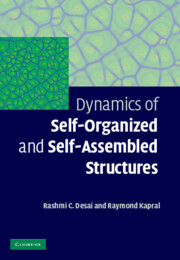Book contents
- Frontmatter
- Contents
- preface
- 1 Self-organized and self-assembled structures
- 2 Order parameter, free energy, and phase transitions
- 3 Free energy functional
- 4 Phase separation kinetics
- 5 Langevin model for nonconserved order parameter systems
- 6 Langevin model for conserved order parameter systems
- 7 Interface dynamics at late times
- 8 Domain growth and structure factor for model B
- 9 Order parameter correlation function
- 10 Vector order parameter and topological defects
- 11 Liquid crystals
- 12 Lifshitz–Slyozov–Wagner theory
- 13 Systems with long-range repulsive interactions
- 14 Kinetics of systems with competing interactions
- 15 Competing interactions and defect dynamics
- 16 Diffusively rough interfaces
- 17 Morphological instability in solid films
- 18 Propagating chemical fronts
- 19 Transverse front instabilities
- 20 Cubic autocatalytic fronts
- 21 Competing interactions and front repulsion
- 22 Labyrinthine patterns in chemical systems
- 23 Turing patterns
- 24 Excitable media
- 25 Oscillatory media and complex Ginzburg–Landau equation
- 26 Spiral waves and defect turbulence
- 27 Complex oscillatory and chaotic media
- 28 Resonantly forced oscillatory media
- 29 Nonequilibrium patterns in laser-induced melting
- 30 Reaction dynamics and phase segregation
- 31 Active materials
- References
- Index
23 - Turing patterns
Published online by Cambridge University Press: 10 February 2010
- Frontmatter
- Contents
- preface
- 1 Self-organized and self-assembled structures
- 2 Order parameter, free energy, and phase transitions
- 3 Free energy functional
- 4 Phase separation kinetics
- 5 Langevin model for nonconserved order parameter systems
- 6 Langevin model for conserved order parameter systems
- 7 Interface dynamics at late times
- 8 Domain growth and structure factor for model B
- 9 Order parameter correlation function
- 10 Vector order parameter and topological defects
- 11 Liquid crystals
- 12 Lifshitz–Slyozov–Wagner theory
- 13 Systems with long-range repulsive interactions
- 14 Kinetics of systems with competing interactions
- 15 Competing interactions and defect dynamics
- 16 Diffusively rough interfaces
- 17 Morphological instability in solid films
- 18 Propagating chemical fronts
- 19 Transverse front instabilities
- 20 Cubic autocatalytic fronts
- 21 Competing interactions and front repulsion
- 22 Labyrinthine patterns in chemical systems
- 23 Turing patterns
- 24 Excitable media
- 25 Oscillatory media and complex Ginzburg–Landau equation
- 26 Spiral waves and defect turbulence
- 27 Complex oscillatory and chaotic media
- 28 Resonantly forced oscillatory media
- 29 Nonequilibrium patterns in laser-induced melting
- 30 Reaction dynamics and phase segregation
- 31 Active materials
- References
- Index
Summary
A Turing pattern forms when a spatially homogeneous steady state, which is stable to small spatially homogeneous perturbations, loses its stability to small spatially inhomogeneous perturbations. The mechanism responsible for such instabilities was first described by Turing (1952), in his paper The chemical basis of morphogenesis, as a model for pattern formation in biology. The appearance ofTuring patterns relies on the interplay between autocatalytic chemical kinetics and diffusion. The basic Turing mechanism can be described in terms of the kinetics of two chemical species termed the activator and the inhibitor. The activator tends to increase the production of chemical species while the inhibitor tends to inhibit such concentration growth. A Turing pattern can form if the diffusion coefficient of the inhibitor is much greater than that of the activator. While there is still controversy over the role of Turing patterns in morphogenesis, these patterns have been unambiguously identified in chemically reacting media.
The formation of a chemicalTuring pattern in a continuously fed unstirred reactor was reported by Castets et al. (1990). The chlorite–iodide–malonic acid system was studied in a thin gel reactor schematically depicted in Fig. 23.1. The top and bottom sides of the thin hydrogel in which the reaction takes place are in contact with reservoirs containing chemical reagents. The chemical species diffuse into the gel, and reaction takes place in a thin layer within the gel shown in the center panel of the figure. Within this reaction zone a stationary inhomogeneous periodic pattern of chemical concentrations develops, as seen in the right panel of the figure.
Information
- Type
- Chapter
- Information
- Dynamics of Self-Organized and Self-Assembled Structures , pp. 201 - 211Publisher: Cambridge University PressPrint publication year: 2009
